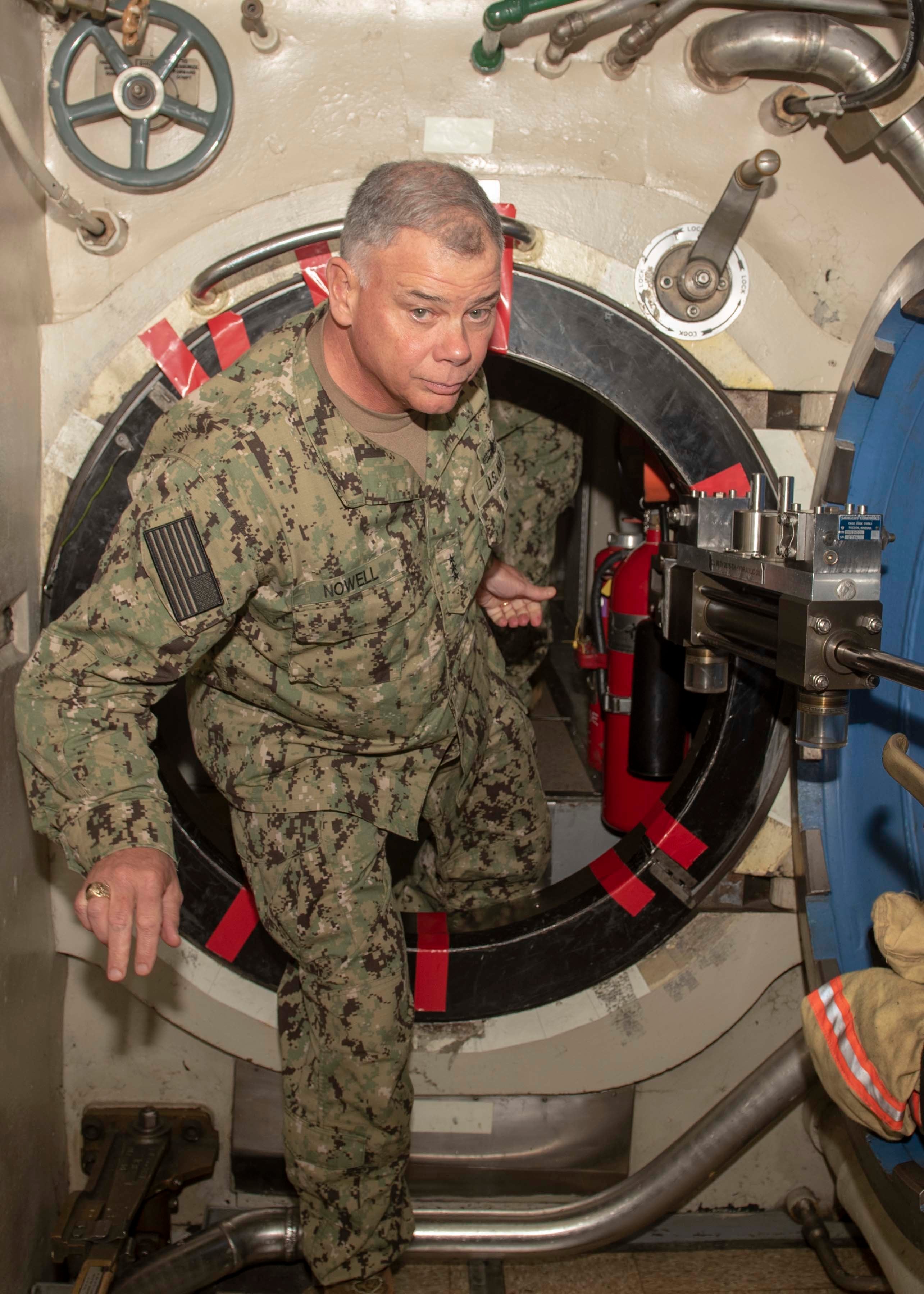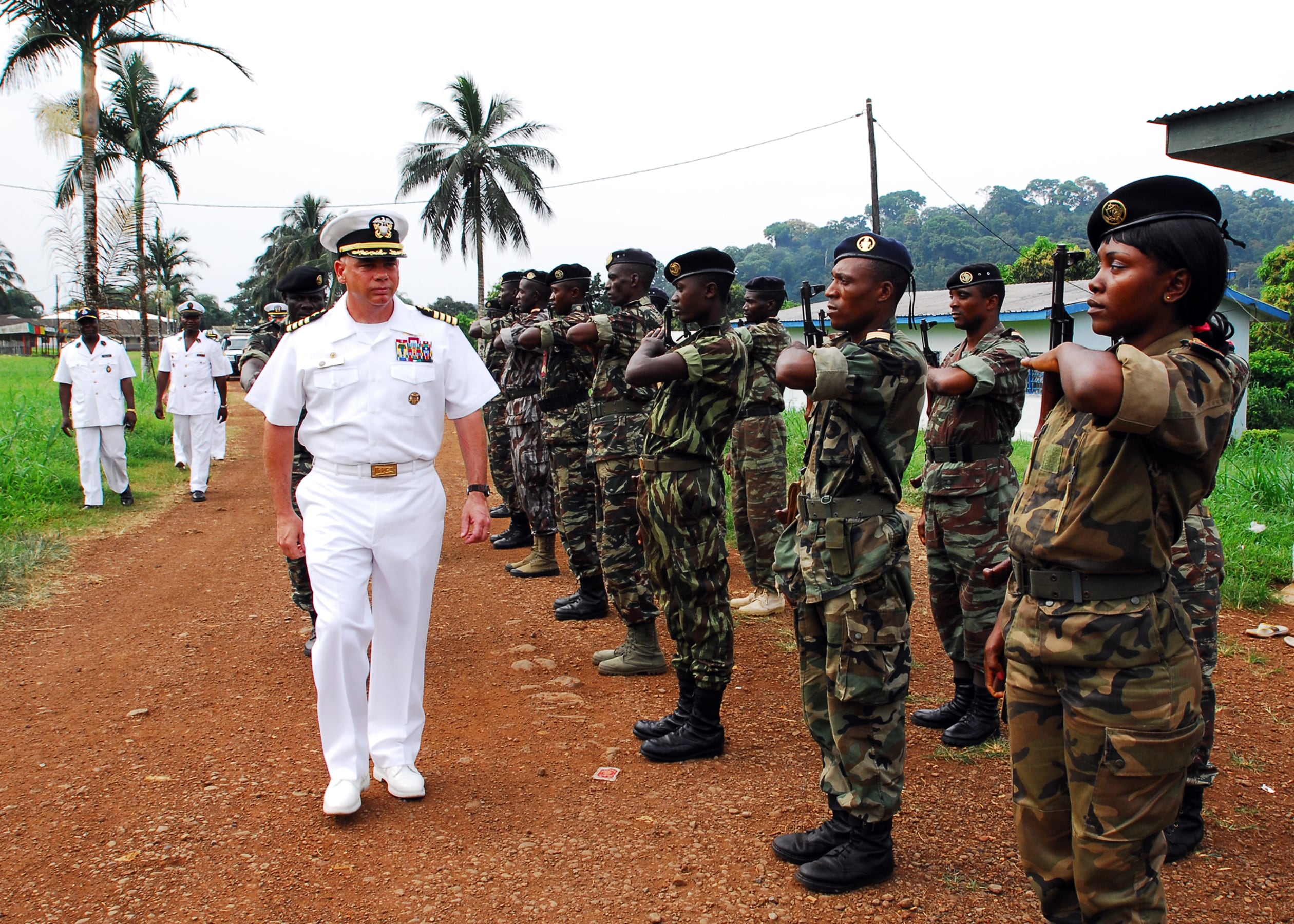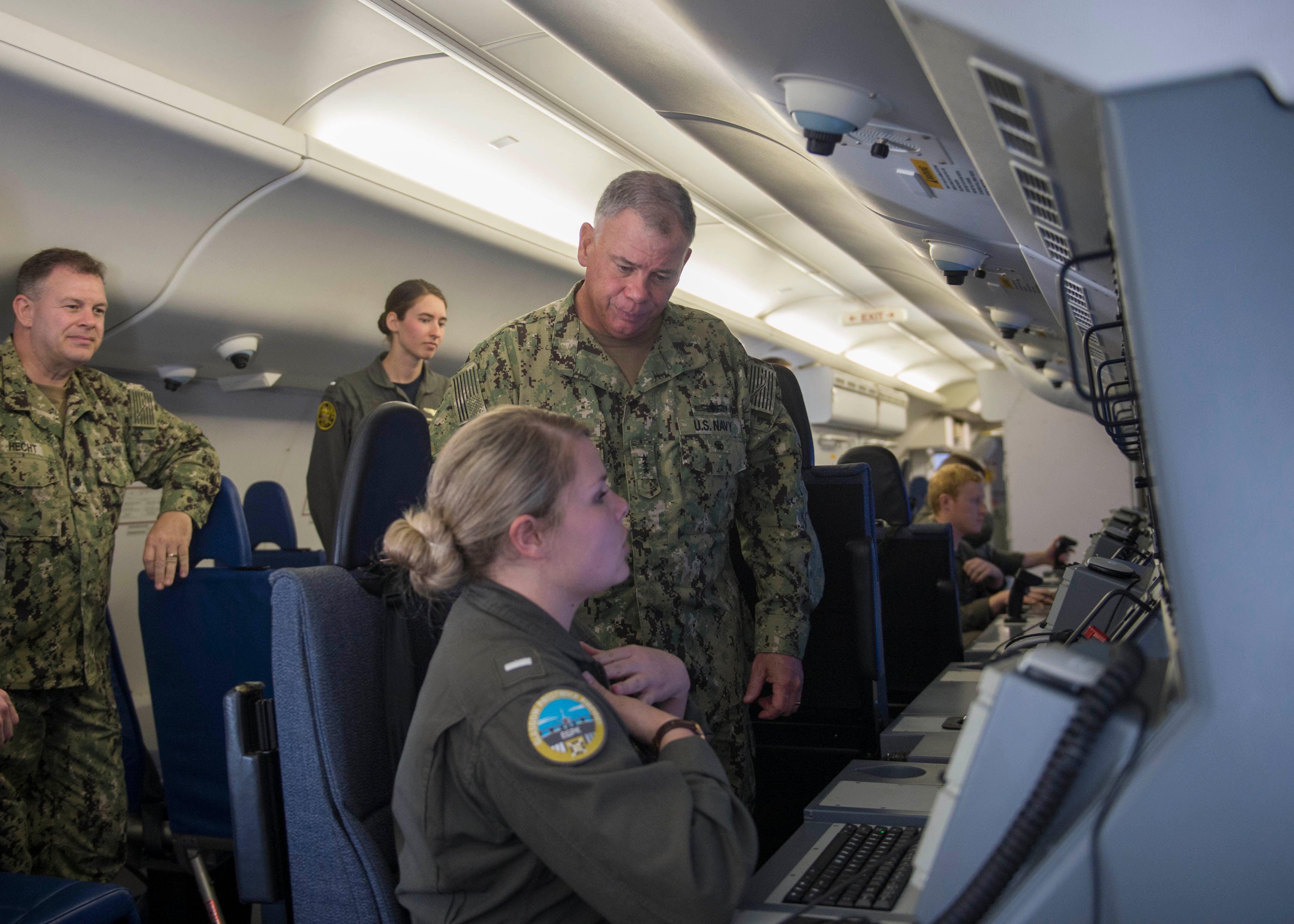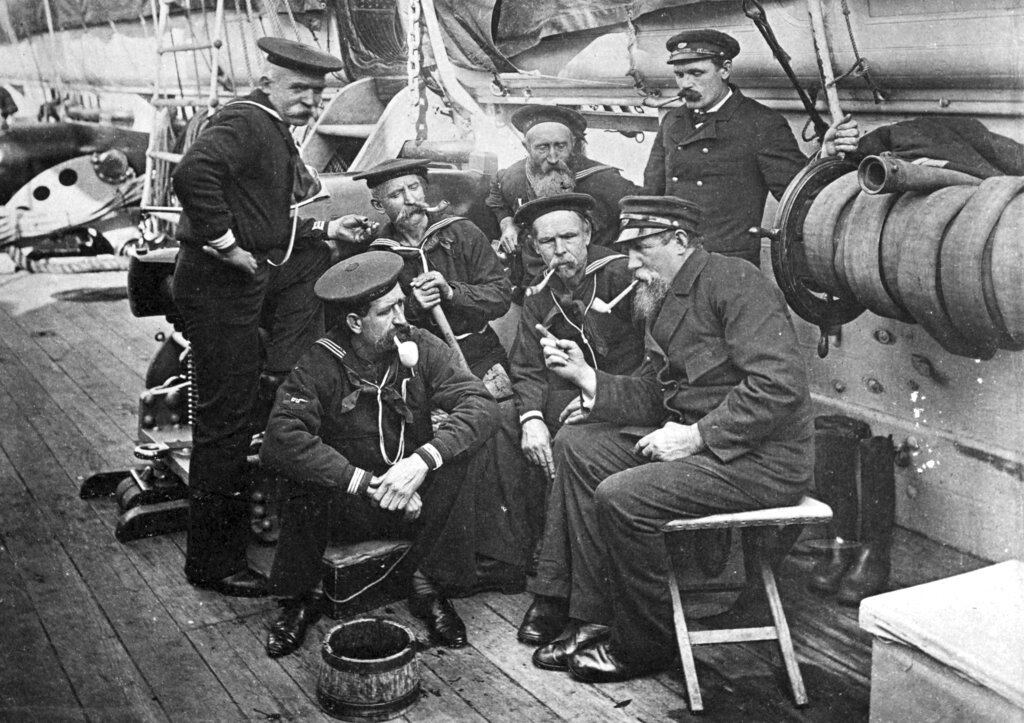Chief of Naval Personnel Vice Adm. John Nowell Jr.’s favorite sea story starts at the U.S. Naval Academy.
When his son, Johnny Nowell III, graduated from Annapolis in 2014, he asked his father — Class of 1984 — for advice.
A career surface warfare officer who commanded the guided-missile destroyer Porter and Destroyer Squadron 60 — plus joint task forces in Lebanon and Africa — Nowell shared three pieces of guidance, gained from his long years at sea.
“First is get out there and work hard,” Nowell recounted during an interview with Navy Times. “Learn your trade and be good at it.
“No. 2: listen to your chiefs. They will help you learn how to become a good division officer. You’ll be the division officer, they’ll be the chief, but that chiefs mess brings a wealth of experience and knowledge to the equation.”
And No. 3?
“Take care of your people and they will take care of you,” Nowell said.
Later, father and son were stationed in Japan. Nowell was commanding Task Force 76 and his son was the first lieutenant on the guided-missile destroyer Mustin when it pulled in to refuel.
Nowell decided to take a tour of the warship, not as a Navy admiral but as a dad. He recalled two chief boatswain’s mates who pulled him aside to tell him his son was “doing a great job.”
“‘He’s a good division officer. He’s built a great team. He’s listened. We have a great division and you ought to be proud.’”
After sharing his story, Nowell wondered if he offered up something too personal. But when you’re the Navy’s leader charged with taking care of every sailor “it’s personal and professional,” he said.
“That’s why we’re working so hard to make it better,” Nowell continued. “We’ve got a lot of progress to be made.”

Nowell picked up his third star and took over as the Navy’s 59th chief of naval personnel on May 24. He’s tasked with leading more than 24,000 personnel who oversee all manpower, training and education resources for the sea service.
That includes the Navy’s ongoing crusade to modernize its sprawling personnel system, an initiative known as Sailor 2025.
Created by retired Vice Chief of Naval Operations Adm. Bill Moran during his reign as CNP, it calls for dozens of separate reforms designed to give sailors more control over their careers while hiking readiness across the fleet.
Moran’s Sailor 2025 brainchild was expanded by Adm. Robert Burke when he served as CNP before following Moran’s path to become VCNO eight months ago.
Their innovations continue under Nowell, who apprenticed as Burke’s deputy for three years. Fleeting up to take the helm of the Navy’s vast human resources system was “very seamless,” Nowell said, and he and Burke remain “totally aligned when it comes to what that vision is and where we need to go.”
“I’m the barrier removal guy,” Nowell added.
“The one thing I think we’ve both been passionate about — certainly I would tell you that I am — you don’t hear me say ‘I,’” Nowell said. “It’s always ‘we.’ It’s the Navy’s HR team.”
Nowell insisted that he wants everyone below him, all the way down to the deck plate level, to feel “empowered.”
“We spend a lot of time talking about what are our goals. Where are we going? How do we make it better? And then, I want them to move out smartly. I don’t want to ask permission.”

Over the past six months, Nowell has visited fleet concentration areas to listen to sailors, and he intends to keep going out to talk shop with shipmates every few months.
“My big goal post, first and foremost, is to continue to address manning in the fleet, whittling down those gaps at sea and ensuring that we have not just a good fill but a good fit,” he said.
Appearing before a panel on transformation during the Surface Navy Association’s annual symposium on Jan. 15 in Arlington, Virginia, Nowell told a ballroom of active duty and retired sailors and private sector executives that his sea service had to come to terms with the “total ownership costs” of manning the fleet.
That involves a wide array of HR challenges, from training sailors and moving their families to new duties stations to slotting them in the right billets before their ships deploy.
Reforms to the way the Navy does all that are expected to hike the number of sailors at sea by more than 4,000 personnel.
In January of 2019, 6,250 billets were gapped, so the flow of sailors to the fleet is expected to bring some relief to crews worldwide.
In 2012, a deploying Arleigh Burke-class guided-missile destroyer was manned with only about 240 officers and crew, partly due to a dip in defense spending during an era marked by a high tempo of Navy operations.
This year, there should be about 265 personnel assigned to a destroyer six months before it deploys. By 2023, Nowell hopes to guarantee 285 on board the warship one year before the cruise starts.
When visiting the fleet now, if he finds a warship that’s 102 percent manned and the commanding officer still reports staffing problems, Nowell says, “Well, how can you have issues? You’re overmanned.”
“The answer is not number of bodies,” Nowell continued. “It is the right fit with those billets.”
To the three-star, addressing all of that requires a careful balance between what he called accessions and tools.
For accessions, the Navy expects to bring in about 40,800 personnel in Fiscal Year 2020, up from a little more than 30,000 four years ago, Nowell said.
But then the sea service must use the proper tools, such as the Navy’s detailing marketplace, to make sure the right sailor ends up in the right job.

One way the service is aiming to match a sailor to the proper billet is through MyNavy Assignment. The online portal replaced the old Career Management System — Interactive Detailing site and is expected to make applying for jobs easier and the selection process more transparent, Navy leaders have said.
Between its Dec. 5 launch and Jan. 16, more than 82,000 active duty and full time support sailors visited the site.
And those who fell within their detailing window submitted more than 78,000 job applications, according to figures provided by Chief of Naval Personnel spokesman Cmdr. Dave Hecht.
The numbers indicate that more than 11,000 sailors bookmarked roughly 27,000 potential billets.
“Commands are looking at who is applying for their jobs while the sailors are looking at the jobs that they can apply for,” Nowell said.
“In some cases, note that it might mean that here are some options for conversion to another similar rating looking at the commonality in training and experience is.”
When the service finds the best fit for its billets it “directly equates to better readiness,” Nowell said.
He pointed to MyNavy Assignment. It links commands and career counselors with sailors to keep them in uniform by finding the best billets to get ahead.
There’s also Advance-to-Position, a program that lets the Navy fill billets that are historically undesirable across the fleet while paving the way for sailors who take on the toughest jobs to advance early.
In the fall, the sea service made that pilot program into a permanent initiative.
RELATED

Much of the ongoing transformation of the Navy’s HR programs requires revamping 55 antiquated systems, including for pay and personnel. Many systems can’t operate with each other. None of them shares a common database, making electronic audits and data mining tricky tasks.
“We’re going to take it into the cloud, where it will actually be more secure than when I’m storing that data now,” Nowell said. “We’re going to enable sailors based upon customer experience, right? What we want is to reduce the pain points that they’ve got in managing their pay, their personnel actions. I don’t want them wasting time trying to figure out, you know, why is it so hard for me to get my travel claim paid? Why does it take so long?”
Young sailors arrive in the fleet as digital natives. They grew up with iPhones or Android devices in their hands in an era of online shopping. They expect instant customer care at their fingertips.
To Nowell, the Navy will be a better place to work once it can offer swift and easy service, too.
“It’s a much smarter way of doing business,” he said.
Courtney Mabeus-Brown is the senior reporter at Air Force Times. She is an award-winning journalist who previously covered the military for Navy Times and The Virginian-Pilot in Norfolk, Va., where she first set foot on an aircraft carrier. Her work has also appeared in The New York Times, The Washington Post, Foreign Policy and more.









